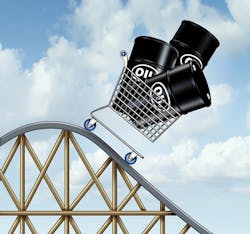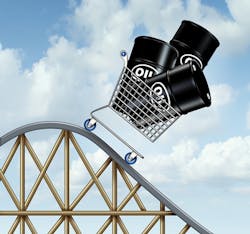To hedge or not to hedge
PROTECT THE COMPANY FROM LOWER PRICES BY STAYING ON PLAN AND ADDING HEDGES THAT MAKE SENSE
JUSTIN W. MCCRANN, AEGIS ENERGY RISK, HOUSTON
AFTER ENJOYING five straight years of prices above $80 per barrel, E&P executives are facing tough decisions given the fall in oil prices. Aside from dropping rigs and cutting G&A, executives are dealing with the conundrum of how to approach oil hedging, given the current price environment.
Before looking forward, let's look at history:
- September 2013: The Syrian crisis has the market nervous. US oil production stood at 7.78 million barrels per day - up 1.5 million over 2012. The oil-directed rig count at around 1300, Oil prices are steeply backwardated with prices near $110 in the front of the curve and Cal 2014 at a mere $96/bbl. Although these were phenomenal prices with excellent rates of return, producers were hesitant to hedge into a backwardated market, which usually resulted in paying out on fixed price as hedges expired. During this extended period of backwardation, many producers were lured into more structures with limited downside protection and fewer swaps with full price protection. As the market turned over from backwardation to contango, an option heavy portfolio proved less favorable.
- August 2015: The Shanghai Composite is imploding. OPEC appears to prefer pumping more crude at $40 than they do at $100. US oil production stands at 9.3 MMb/d and is trending down. The oil-directed rig count is below 700. The oil curve is in contango with prices at $38 in the front month and $45 to $50 down the curve. Now the conversation is generally that the outlook is bleak and $50 sounds like a great swap price, if only available. A massive shift in both fundamentals and sentiment - all in a relatively short period of time.
Now we look forward, the market has generally divided into the two camps of forward views:
- The Bulls believe a lack of capital investment in the US (and globally) will keep rig counts low and lead to a natural decline in production. A sharp drop in production will allow demand to catch up, thus balancing the market and sending prices higher in the future.
- The Bears believe that increased efficiencies, lower drilling costs and relentless OPEC supply will keep oil production steady. Couple that outcome with flat demand out of Europe, in addition to a slowing Chinese economy, and the supply/demand imbalance will keep us in a low price environment for years to come.
The analysts, traders, and other talking heads all have their opinions on the market. Some of those opinions seem to change with the wind. For instance, prices rally above $60 early this summer and suddenly sentiment shifts to optimistic on price - The tide has turned!
Prices then fall below $40 in late summer and - It's the end of the world!...again.
Speculators place their bets and producers and consumers set their hedges, more times than not out of reaction to the market volatility and emotion. The truth is that even the best trader, analyst, hedge fund, portfolio manager, that guy from accounting, and especially your opinionated neighbor all have no idea what the actual outcome will be. Successful players in the market arm themselves with all the information at hand and make intelligent, educated decisions.
So, in the current environment-with so much uncertainty, volatility and echos of $100 oil-the question arises almost daily in every E&P company: How do we protect the company? The answer? With a fundamentally driven view on the market and a structured plan on how to achieve a smart hedge portfolio.
Back to the two camps of thought:
- The Bulls: "The market is going up, prices have to be much higher by this time next year, why would I hedge?"
- The Bears: "We need swap in every barrel, prices are going to $30, all the top analysts agree."
In either case, the first step is to make a plan with ultimate targets for hedge percentages going forward and establish deadlines for implementation. This prevents a very common situation that E&P companies find themselves in - one where they have waited for the optimal time to hedge and find themselves under-hedged in an unattractive price environment.
The next step is to develop a view on the price environment going forward that is based on current fundamental drivers in the market. The final step is to structure the hedges within the portfolio according to that forward view. Ultimately, you want to build a portfolio consisting of both options and fixed price swaps and weight that portfolio given the view. The producer's primary goal however is always the same: Protect the company from lower prices.
Given the recent price drop, our view generally is that hedge portfolios should favor fewer swaps and more option structures. This fits the bullish camp, as the hedges can generally participate as the market moves up, and it protects the bearish camp from getting underwater in a swap heavy hedge portfolio as prices turn up. Most importantly, it protects both camps from longer term low price environment and prevents an under hedged scenario from continuing.
Lastly, one of the lessons that I learned early on in my career as a speculative trader: Emotion clouds judgment. Unfortunately, many hedging decisions made within E&P companies are emotional reactions to the market vacillations. As prices spike, it easy to get caught up in the fervor and expect higher and higher pricing. Conversely, when the bottom drops out, it is hard not to panic. Left unabated, this can lead to a hedge portfolio that hurts more than it helps the company.
E&P companies need to develop and stick with the plan, adding hedges that make sense given both the current market and the existing hedges in place. It can be as simple as a quarterly review of the hedge portfolio or as complex as a regimented calendar of percentages and deadlines. Staying on plan minimizes the decision making and ensures that the company is always protected. Having an educated view on the markets ensures effective hedge structures and better overall performance.
ABOUT THE AUTHOR
Justin W. McCrann is President of Aegis Energy Risk, which provides hedge advisory services to a broad range of upstream clients, including both public and privately held firms. He has served in the industry the past 17 years with experience in all aspects of energy trading and price risk management. Prior to Aegis, he served as Head of East Trading at BNP Paribas in Houston managing energy portfolios and mitigating risk for client hedging activities. Before that, he worked at Merrill Lynch/Allegheny Energy Global Markets where he was tasked with regional energy markets. McCrann is a graduate from the College of Business at James Madison University.

